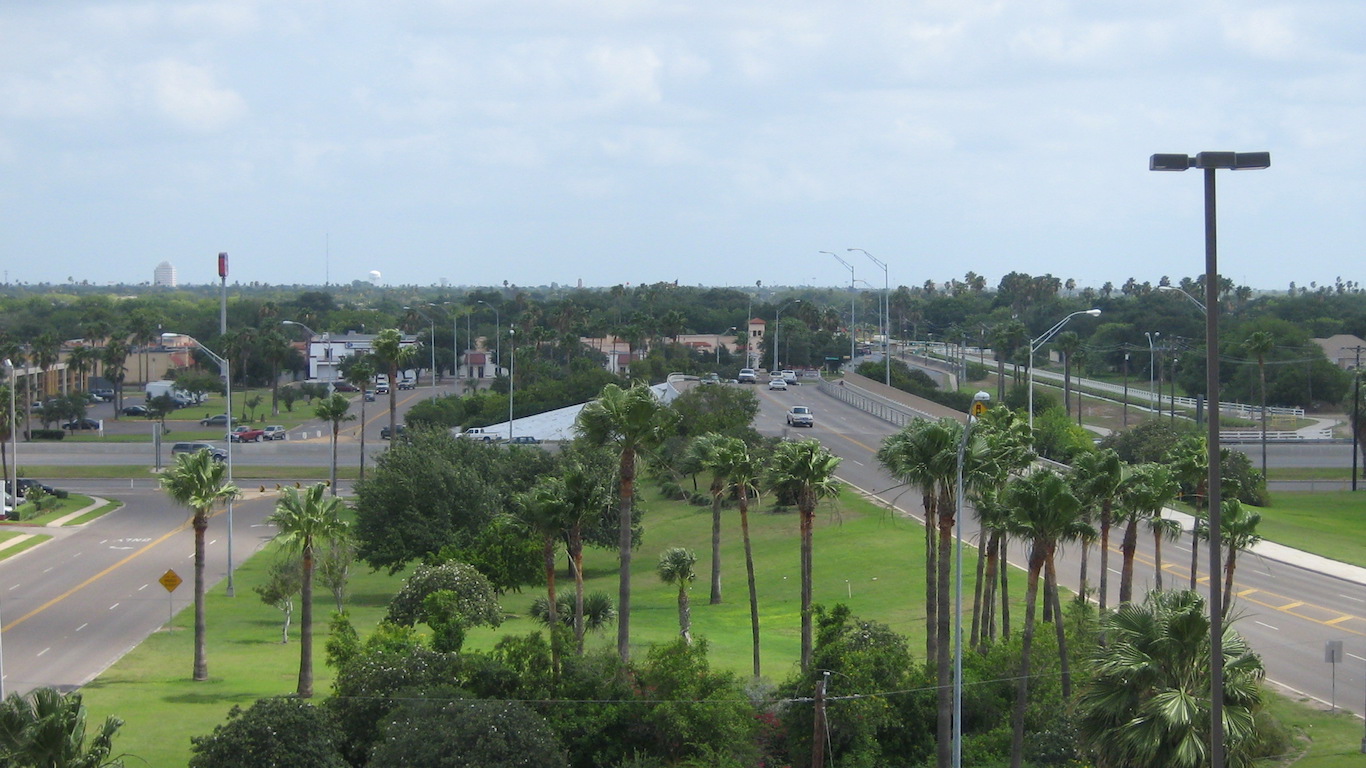Special Report
Cities With the Lowest Risk of Heart Attack

Published:
Last Updated:

Heart disease is the leading cause of death in the United States, accounting for one out of every four deaths each year. Some estimate the costs of heart-related health problems will rise to as high as $3.6 trillion annually within a decade. Cardiovascular problems can lead to heart attacks, which range from undetectable, minor incidents to heart failure and death. The prevalence of heart disease varies considerably across the United States.
24/7 Wall St. reviewed reviewed the incidence of heart attack in 190 U.S. metropolitan areas. We examined the percentage of adults in each area who have been told by a medical practitioner that they have had a heart attack. These data came from “2015 Community Rankings for Incidence of Heart Attack,” a report from Gallup-Healthways. Boulder leads the nation as the city where the smallest percentage of adults have had heart attacks.
[in-text-ad]
Five of the 16 cities with the lowest prevalence of heart attack are in California, while most of the remaining areas are located across the midwest and southwestern United States. In a study tracing heart disease mortality from 1973 to 2010 that was published in March, CDC researchers found that the geographic patterns of heart-related deaths have shifted dramatically. While 40 years ago the highest heart disease mortality was concentrated in the Northeast, death rates have fallen dramatically in the region. Today, the highest concentration has shifted to the South.
Click here to see the cities where the fewest people have heart attacks.
Click here to see the cities where the most people have heart attacks.
Dr. Matthew Ritchey, an epidemiologist with the Division for Heart Disease and Stroke Prevention at the Centers for Disease Control and Prevention, said in an email to 24/7 Wall St.,
“The consistent progression southward over the past few decades suggests that the pattern is not random – and could be attributed to geographic differences in community-level prevention and treatment opportunities.”
Gallup’s report highlighted the heavy toll heart disease takes on individuals, families, and caregivers. Individuals with a history of heart attack are considerably more likely than those who have never been diagnosed to miss work and be admitted to a hospital, for example. The average American reports seven physically or mentally unhealthy days in a given month. Most of the 15 metros with the lowest prevalence of heart attacks report fewer unhealthy days in a month compared to the national average.
Certain behaviors and health conditions are known to increase the risk of heart attack. In the metros with the lowest incidence of heart attacks, these behaviors and conditions tend to be less common. Ritchey noted the prevalence of heart attacks largely depends on “the degree of heart attack risk factors a community has, which include poor blood pressure control, high cholesterol levels, smoking, obesity and physical inactivity.”
Only three of the 15 metro areas on this list have a smoking rate that exceeds the national adult smoking rate of 17%. Similarly, the obesity rate in just five of the 15 areas exceeds 30%, higher than in most metropolitan areas.
A range of socioeconomic factors appear related to a low prevalence of heart attack. High educational attainment in a population often accompanies positive health outcomes. A college degree helps ensure a decent wage — income needed for medical expenses, accessing exercise venues, alleviating stress from finances, etc. — and is often directly related to healthy choices that lower the risk of heart disease.
To identify the cities where the lowest percentage of adults have had heart attacks, 24/7 Wall St. examined “2015 Community Rankings for Incidence of Heart Attack,” a Gallup-Healthways report that reviewed 190 U.S. metropolitan areas. Gallup’s survey was based on 353,983 telephone interviews with U.S. adults across all 50 states and the District of Columbia and was conducted from January 2, 2014 to December 30, 2015. Participants were asked, “Have you ever been told by a physician or nurse that you have had a heart attack?” The percentage of adults with high blood pressure, high cholesterol, a history of diabetes or depression, as well as the obesity rate also came from Gallup. Median household income, poverty rate, and educational attainment came from the U.S. Census Bureau’s 2015 American Community Survey. The smoking rate came from County Health Rankings and Roadmaps.
These are the cities with the lowest risk of heart attack.

16. McAllen-Edinburg-Mission, TX
> Pct. who have had a heart attack: 2.3% (tied)
> Obesity rate: 40.2%
> Smoking rate: 14.9%
> Median household income: $35,730
The incidence of heart attack in McAllen-Edinburg-Mission is one of the lowest in the nation, with 2.3% of adults reporting they have experienced a heart attack in their lifetime. McAllen area residents also report a relatively low level of excessive drinking, at 14.4% of adults, and a relatively low adult smoking rate of 14.9%.
[in-text-ad]
Compared with other cities where relatively few people have heart attacks, however, the McAllen area is otherwise somewhat unique. Being obese can raise blood cholesterol and increase the risk of heart attack, and therefore most cities with low heart attack rates have low obesity rates. Yet, in McAllen, more than 40% of people are obese, nearly the highest obesity rate in the nation. Also, while financial prosperity is usually closely tied to cardiovascular health and good health in general, McAllen residents are not especially wealthy. Nearly one in three people live in poverty, double the national poverty rate.

15. Oxnard-Thousand Oaks-Ventura, CA
> Pct. who have had a heart attack: 2.3% (tied)
> Obesity rate: 23.9%
> Smoking rate: 11.2%
> Median household income: $80,032
Just 2.3% of adults living in the Oxnard-Thousand Oaks-Ventura metropolitan area have experienced a heart attack in their lifetimes. The California area’s residents are healthy by other measures as well. They have lower than typical rates of high blood pressure, high cholesterol, diabetes, depression, and obesity.
Heart disease is the leading cause of death in the United States, and the extremely low rate of heart attacks likely helps explain the metropolitan area’s extremely low rate of premature death. Just 233 of every 100,000 residents die before the age of 75 from preventable causes, less than half the rate of most major metropolitan areas.

14. Jackson, MS
> Pct. who have had a heart attack: 2.3% (tied)
> Obesity rate: 30.4%
> Smoking rate: 19.5%
> Median household income: $46,757
Jackson has one of the lowest shares of adults who have experienced a heart attack in their lifetimes. However, the Mississippi capital does not fit the usual profile of a metropolitan area with an extremely low incidence of heart attacks. For example, 35% of adults report high blood pressure — a risk factor for heart disease — higher than most metropolitan areas. Also, slightly more than 30% of Jackson’s adults are obese, worse than the majority of major metropolitan areas.
Social and economic conditions such as poverty are tied to health conditions such as diabetes and obesity, as well as heart disease. Jackson is also unusual among metropolitan areas with a relatively small share of adults who have had heart attacks in that it is a relatively poor place. The city’s 19.4% poverty rate is well above the national rate of 14.7%.

13. San Diego-Carlsbad, CA
> Pct. who have had a heart attack: 2.2%
> Obesity rate: 22.3%
> Smoking rate: 11.8%
> Median household income: $67,320
Predisposition for heart disease can be genetic, but a number of healthy behaviors can help reduce the risk of a heart attack. The population of San Diego, which has one of the lowest heart attack rates in the country, is less likely to engage in unhealthy behavior. The area’s population reports among the lowest shares of smoking, obesity, and sedentary lifestyles, which are all risk factors heart disease.
Heart disease is currently the leading cause of death in the United States, and with a low heart attack rate pointing to generally better heart health among residents, San Diego residents unsurprisingly are more likely to live full lives than those in most metropolitan areas. Just 255 out of every 100,000 area residents die due to preventable causes before the age of 75, much lower than the national rate of 474 premature deaths per 100,000 people.

12. Salt Lake City, UT
> Pct. who have had a heart attack: 2.2%
> Obesity rate: 24.9%
> Smoking rate: 10.1%
> Median household income: $65,792
Salt Lake City residents, who report one of the lowest incidence of heart attack among U.S. metro areas, do not engage in many of the healthy behaviors known to increase the risk of heart attack. Just 10% of area adults report a smoking habit, for example, among the lowest rates of any U.S. metro area. While excessive drinking is relatively common even in some of the nation’s healthier communities, such behavior can certainly still increase the risk of heart problems. In Salt Lake City, just 14.1% of adults report excessive drinking, one of the lowest shares in the country.
[in-text-ad]
Economic prosperity can also go a long way toward better health outcomes. Like many other cities with low incidence of heart attack, the median household income in Salt Lake City of $65,792 a year is well above the national median income of $55,772 a year. The city’s poverty rate of just 10.2% is also one of the lowest in the country.

11. Kalamazoo-Portage, MI
> Pct. who have had a heart attack: 2.2%
> Obesity rate: 28.9%
> Smoking rate: 16.5%
> Median household income: $51,167
Kalamazoo has one of the lowest heart attack rates in the country, although the area lacks some of the characteristics typical of other metro areas on this list. For example, the region has a poverty rate higher than the U.S. figure, and the typical household earns below the U.S. median household income.
For several reasons, areas with a high share of college-educated residents also tend to have lower rates of heart disease. A college degree can lead to higher-paying jobs, which in turn allow residents to be able to afford better medical care healthier lifestyle choices. College-educated residents may also be more likely to make informed health decisions. Kalamazoo has one of the higher shares among metropolitan areas of both high school- and college-educated adults.

10. Green Bay, WI
> Pct. who have had a heart attack: 2.2%
> Obesity rate: 31.0%
> Smoking rate: 16.0%
> Median household income: $54,847
Several major metropolitan areas in Wisconsin have a relatively low incidence of heart attack, but none as low as Green Bay, where just 2.2% of adults reported experiencing such an event. Green Bay area residents are much less likely to have some risk factors typically associated with heart disease, but much more likely to have others. Compared to other major metropolitan areas, Green Bay adults have among the highest shares of high cholesterol and obesity, but among the lowest shares of high blood pressure and diabetes.
Such a low rate of heart attack points to generally good heart among Green Bay’s population. Possibly for this reason, residents are more likely than those in most metropolitan areas to live a full life. Just 290 residents out of every 100,000 people die each year before reaching the age of 75 due to preventable causes, much lower than the national rate of 474 premature deaths per 100,000 people.

9. Gainesville, FL
> Pct. who have had a heart attack: 2.1%
> Obesity rate: 25.2%
> Smoking rate: 18.3%
> Median household income: $46,949
Some metropolitan areas in Florida report very high incidence of heart attack, while others report very low incidence. In North Port and Deltona metro areas, at least 7% of adults report having had a heart attack, one of the higher rates of all the nation’s metro areas. Meanwhile, just 2.1% of Gainesville residents report the same, lower than in all but a handful of U.S. metropolitan areas.
[in-text-ad]
People living in poverty are at greater risk of heart disease and other potentially preventable conditions as they are less likely to have access to nutritious food, exercise opportunities, and quality health care. Despite this, Gainesville has one of the higher poverty rates in the country, at 21.9%, significantly higher than the national rate of 14.7%.

8. San Luis Obispo-Paso Robles-Arroyo Grande, CA
> Pct. who have had a heart attack: 2.1%
> Obesity rate: 23.9%
> Smoking rate: 12.4%
> Median household income: $62,648
Maintaining a healthy weight is one of the most effective ways to lower the risk of heart disease. Less than 25% of adults living in the San Luis Obispo area are obese, one of the lowest proportions in the United States. The percentage of adults with no leisure time to exercise is greater than 20% in the majority of metro areas surveyed by Gallup. In the San Luis area, however, 15% of residents report no leisure time for exercise — also one of the lower shares nationwide.
Financial well-being is closely tied with favorable health outcomes. When it comes to costly medical bills, the two can even be directly related. So, as is generally the case, San Luis Obispo area residents, who are some of the least likely to suffer from a heart attack, are also relatively wealthy. The typical household earns $62,648 a year, higher than the national median income of $55,772 a year.

7. Visalia-Porterville, CA
> Pct. who have had a heart attack: 2.0%
> Obesity rate: 33.2%
> Smoking rate: 15.4%
> Median household income: $42,413
Being obese and smoking can increase the risk of heart problems. The Visalia area has nearly the lowest incidence of heart attack of U.S. metro areas. But while the metro’s smoking rate of 15.4% is below average, its obesity rate of 33.2% is high compared with most major metropolitan areas, and particularly high compared to most cities with low heart attack rates.
Apart from its low heart attack incidence, several social and economic factors in the Visalia-Porterville metro area are uncharacteristically poor compared with healthy communities. For instance, just 14.2% of adults have a college degree, half the national percentage, and 27.6% of people live in poverty, one of the highest poverty rates nationally.

6. San Jose-Sunnyvale-Santa Clara, CA
> Pct. who have had a heart attack: 1.9%
> Obesity rate: 19.9%
> Smoking rate: 9.1%
> Median household income: $101,980
San Jose-Sunnyvale-Santa Clara is one of only a handful of metro areas with less than 2% of adults reporting having had a heart attack. Heart disease places a heavy toll on individuals. For people with recent heart problems, adopting healthy behaviors associated with cardiovascular health is especially challenging. On the whole, San Jose area residents seem to have healthy habits. Fewer than one in 10 adults are smokers, fewer than one in five individuals are obese, and approximately 15% report no physical exercise — each among the lowest such proportions of U.S. metro areas.
[in-text-ad]
Financial stability can make it considerably easier to stay healthy and meet health goals. Wealthier individuals who do not have healthy habits are still more likely than poorer individuals to survive a heart attack. The typical San Jose area household earns more than $100,000 a year, by far the highest median income of U.S. metros.

5. Austin-Round Rock, TX
> Pct. who have had a heart attack: 1.8%
> Obesity rate: 24.6%
> Smoking rate: 12.3%
> Median household income: $67,195
In Austin, just 1.8% of adults have experienced a heart attack in their lifetimes. Obesity and associated medical conditions such as diabetes are among the leading causes of heart disease. In Austin, less than 25% of adults are obese, while in several other Texas metropolitan areas between 30% and 40% of adults are obese. Similarly, only 9.3% of area residents are diabetic, while in several state metro areas more than 15% of adults are diabetic.
For a number of reasons, higher educational attainment is tied to lower incidence of heart disease. This may be in part because people with a college degree are more likely to make informed healthy choices. A college degree also tends to lead to higher-paying jobs, which in turn allow residents to be able to afford healthier lifestyle choices and better medical care. In Austin, 42.6% of adults have a college degree, among the highest share of any major metropolitan area.

4. Provo-Orem, UT
> Pct. who have had a heart attack: 1.6%
> Obesity rate: 22.5%
> Smoking rate: 7.0%
> Median household income: $65,092
While no one is immune to the possibility of heart disease, certain behavior has been shown to help reduce the risk of heart disease. Provo-Orem’s population in many ways reflects the ideals of healthy behavior, which likely explains its extremely low rate of heart disease. The metro area has among the lowest shares of adults reporting sedentary behavior, as well as the lowest rates of both smoking and excessive alcohol consumption of any metropolitan area in the country.
Likely at least in part because of the residents’ healthy behavior, Provo also has among the lowest rates of other health conditions associated with heart disease. Among the 190 metropolitan areas surveyed by Gallup, Provo had among the three lowest rates of high blood pressure and diabetes, as well as the lowest share of adults with high cholesterol.

3. Tallahassee, FL
> Pct. who have had a heart attack: 1.5%
> Obesity rate: 31.2%
> Smoking rate: 18.4%
> Median household income: $44,295
Because high blood pressure, smoking, and obesity all increase the risk of heart disease, communities where these conditions and behaviors are common tend to also have a higher incidence of heart attack. In Tallahassee, however, 30.8% of adults report high blood pressure, 18.4% of adults smoke, and 31.2% are obese — each on the higher end among U.S. metros in general and exceptionally high compared with metros on this list.
[in-text-ad]
Yet Tallahassee residents are some of the least likely to have suffered from a heart attack. The low incidence of high cholesterol in the city, at less than 20% of adults, could partially explain the low heart attack incidence. Like other communities with low heart attack incidence, Tallahassee residents are also relatively well educated. More than 35% of adults have at least a college degree, higher than the corresponding national educational attainment rate of just over 30%.

2. Ann Arbor, MI
> Pct. who have had a heart attack: 1.3% (tied)
> Obesity rate: 28.9%
> Smoking rate: 14.3%
> Median household income: $61,977
With just 1.3% of adults reporting a history of heart attack, Ann Arbor is tied with Boulder, Colorado for having the lowest incidence of heart attack in the nation. The population of communities with low incidence of heart attack typically also report low rates of conditions and behaviors that lead to heart problems. Ann Arbor is no exception. Of adults in the area, 22% have high blood pressure, 18% have high cholesterol, and just 7.4% have diabetes, each among the lowest levels in the country. Because diabetes causes sugar to build up in the blood, diabetics are considerably more vulnerable to heart attacks compared to people without diabetes.

1. Boulder, CO
> Pct. who have had a heart attack: 1.3% (tied)
> Obesity rate: 16.4%
> Smoking rate: 10.9%
> Median household income: $72,009
With healthy eating and exercise habits, the risk of heart attack can be lowered substantially. Such healthy behaviors among Boulder residents likely explain the city’s 1.3% incidence of heart attack among adults, tied with Ann Arbor, Michigan for the lowest in the nation. Just 9.4% of adults in Boulder report having no leisure time for physical activity, the lowest percentage of any U.S. metro area and the only city in the country where fewer than one in every 10 adults exercise so little. Avoiding tobacco and staying within the range of a healthy body size decreases the risk of heart disease, and this appears to be especially the case in Boulder. The city’s smoking and obesity rates of 10.9% and 16.4% respectively are among the lowest of any U.S. metro.
A college degree helps ensure a decent wage — income for medical expenses, healthier lifestyles, alleviating stress caused by financial hardship, and more. Education is also often directly related to healthy choices that lower the incidence of heart disease. More than 60% of Boulder adults have at least a college degree, the highest share in the nation.
Ever wanted an extra set of eyes on an investment you’re considering? Now you can speak with up to 3 financial experts in your area for FREE. By simply
clicking here you can begin to match with financial professionals who can help guide you through the financial decisions you’re making. And the best part? The first conversation with them is free.
Click here to match with up to 3 financial pros who would be excited to help you make financial decisions.
Thank you for reading! Have some feedback for us?
Contact the 24/7 Wall St. editorial team.